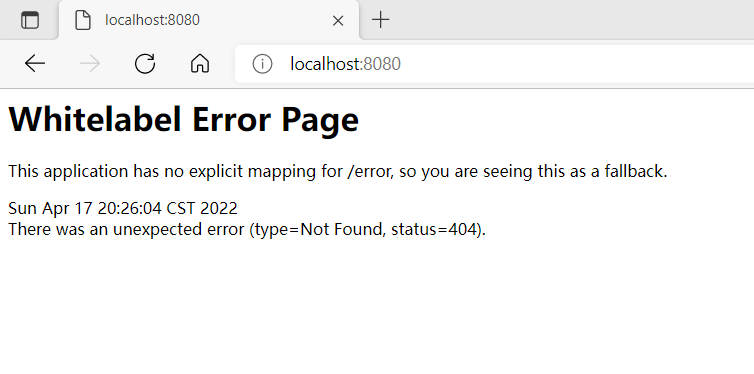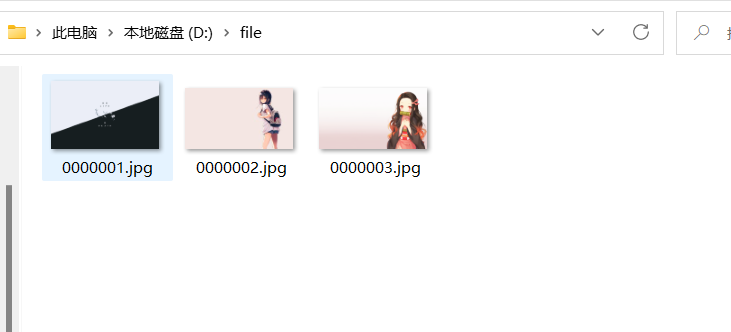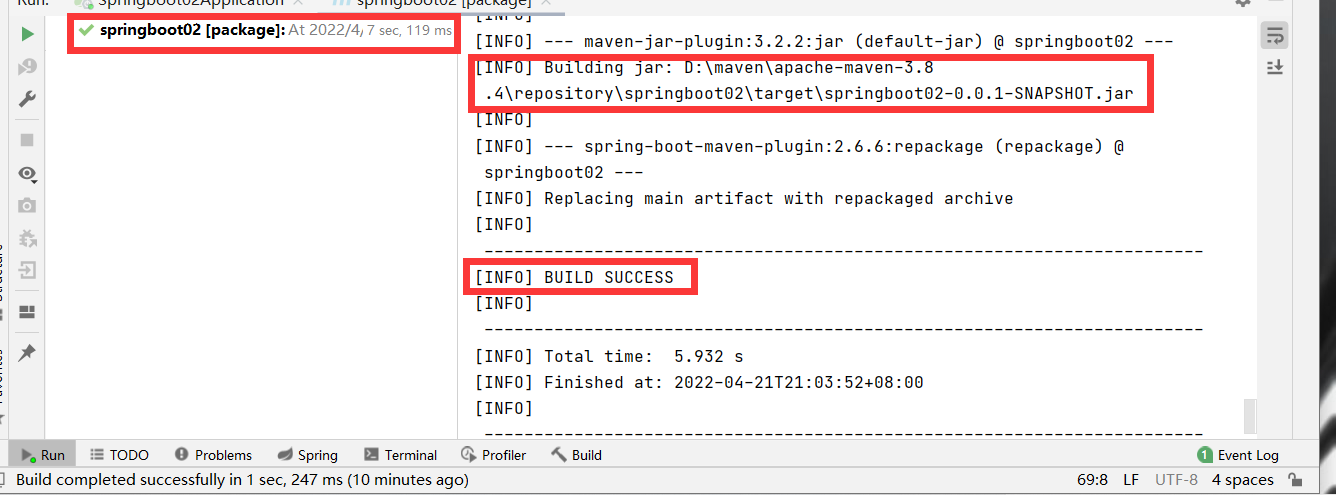通常在 Web 开发中,会涉及静态资源的访问支持、视图解析器的配置、转换器和格式化器的定制、文件上传下载等功能,甚至还需要考虑到与Web服务器关联的 Servlet相关组件的定制。Spring Boot框架支持整合一些常用Web框架,从而实现Web开发,并默认支持Web开发中的一些通用功能。本文将对Spring Boot实现Web开发中涉及的三大组件Servlet、Filter、Listener以及文件上传下载功能以及打包部署进行实现。
SpringMVC整合支持为了实现并简化Web开发,Spring Boot为一些常用的Web开发框架提供了整合支持,例如 Spring MVC、Spring WebFlux等框架。使用Spring Boot进行Web开发时,只需要在项目中引入对应Web开发框架的依赖启动器即可。
Spring MVC自动配置在Spring Boot项目中,一旦引入了Web依赖启动器spring-boot-starter-web,那么SpringBoot整合 Spring MVC 框架默认实现的一些xxxAutoConfiguration自动配置类就会自动生效,几乎可以在无任何额外配置的情况下进行Web开发。Spring Boot为整合Spring MVC 框架实现Web开发,主要提供了以下自动化配置的功能特性。
(1)内置了两个视图解析器:ContentNegotatingViewResolver和BeanNameViewReso
(2)支持静态资源以及WebJars。
(3)自动注册了转换器和格式化器。
(4)支持Http消息转换器。
(5)自动注册了消息代码解析器。
(6)支持静态项目首页index.html。
(7)支持定制应用图标favicon.ico。
(8)自动初始化Web数据绑定器ConfigurableWebBindinglnitializer。
Spring Boot 整合 Spring MVC进行Web开发时提供了很多默认配置,而且大多数时候使用默认配置即可满足开发需求。例如,Spring Boot整合Spring MVC进行Web开发时,不需要外配置视图解析器。
Spring Boot 整合 Spring MVC进行Web开发时提供了很多的自动化配置,但在实际开发中还需要开发者对一些功能进行扩展实现。下面我们通过一个具体的案例讲解 Spring Boot整合Spring MVC框架实现Web开发的扩展功能。
项目基础环境搭建使用Spring Inifializr方式创建名称为springboot02的Spring Boot项目,并导入Web依赖和Thymeleaf依赖。
让后我们启动该项目访问http://localhost:8080/ 可以看到下面的界面就表示访问成功,也代表我们项目创建成功。

我们在resources下的templates包里创建一个登录界面login.html
<!DOCTYPE html>
<html>
<head>
<title>login</title>
</head>
<body>
<form>
<input type="text" name="username">
<input type="password" name="password">
<input type="submit" value="submit">
</form>
</body>
</html>
最后在com.hjk包下创建controller包并创建LoginController类
package com.hjk.controller;
import org.springframework.stereotype.Controller;
import org.springframework.ui.Model;
import org.springframework.web.bind.annotation.GetMapping;
import java.util.Calendar;
@Controller
public class LoginController {
/**
* 获取并封装当前年份跳转到登录页login.html
*/
@GetMapping("/toLoginPage")
public String toLoginPage(Model model){
model.addAttribute("currentYear", Calendar.getInstance().get(Calendar.YEAR));
return "login";
}
}
接下来使用Spring Boot 整合Spring MVC进行Web开发,实现简单的页面跳转功能,这里我们将使用Spring Boot提供的WebMvcConfigurer接口编写自定义配置,并对Web功能进行适当扩展。我们在这里分别演示视图管理器和拦截器的实现。
注册视图管理器在springboot项目的 com.hjk下创建config包并创建一个实现WebMvcConfigurer 接口的配置类 MyMVCconfig,用于对 MVC框架功能进行扩展
package com.hjk.config;
import org.springframework.context.annotation.Configuration;
import org.springframework.web.servlet.config.annotation.InterceptorRegistry;
import org.springframework.web.servlet.config.annotation.ViewControllerRegistry;
import org.springframework.web.servlet.config.annotation.WebMvcConfigurer;
import javax.annotation.Resource;
@Configuration
public class MyMVCconfig implements WebMvcConfigurer {
@Override
public void addViewControllers(ViewControllerRegistry registry){
registry.addViewController("/toLoginPage").setViewName("login");
registry.addViewController("/login.html").setViewName("login");
}
}
- MMVCconig实现了接口 WebMvcConigurer 的addViewControllerse(ViewControllerRegistry registry)方法。在addViewControllers()方法内部,使用ViewControllerRegistry的 addviewController()方法分别定义了“tologinPage”和“login.html”的请求控制,并使setViewName("login")方法将路径映射为login.html页面。
定制完MVC的视图管理功能后, - 就可以进行效果测试了。为了演示这种定制效果,重启chapter05项目,项目启动成功态,在浏览器上分别访问http://localhost:8080/toLoginPage和http://localhost:8080/login.htm 都可以访问login.html页面
- 使用WebMvcConfigurer接口定义的用户请求控制方法也实现了用户请求控制跳转的效果,相比于传统的请求处理方法而言,这种方法更加简洁、直观和方便。同时也可以看出,使用这种方式无法获取后台处理的数据。需要说明的是,使用WebMvcConfigurer 接口中的addViewControllers(ViewControllelRegistry registry)方法定制视图控制,只适合较为简单的无参数视图Get方式请求,有参数或需要业务处理的跳转需求,最好还是采用传统方式处理请求。
WebMvcConfigurer接口提供了许多MVC开发相关方法,添加拦截器方法addInterceptors(),添加格式化的器的方法addFormatters()我们这里实现拦截器的方法。
我们在config包下创建一个自定义拦截器类MyInterceptor,代码如下。
package com.hjk.config;
import org.springframework.stereotype.Component;
import org.springframework.web.servlet.HandlerInterceptor;
import org.springframework.web.servlet.ModelAndView;
import javax.servlet.http.HttpServletRequest;
import javax.servlet.http.HttpServletResponse;
import java.io.IOException;
import java.util.Calendar;
@Component
public class MyInterceptor implements HandlerInterceptor {
@Override
public boolean preHandle(HttpServletRequest request, HttpServletResponse response, Object handler) throws Exception {
String uri = request.getRequestURI();
Object loginUser = request.getSession().getAttribute("loginUser");
if (uri.startsWith("/admin")&& null==loginUser){
try {
response.sendRedirect("/toLoginPage");
} catch (IOException e) {
e.printStackTrace();
}
return false;
}
return true;
}
@Override
public void postHandle(HttpServletRequest request, HttpServletResponse response, Object handler, ModelAndView modelAndView) throws Exception {
System.out.println("拦截器拦截");
}
@Override
public void afterCompletion(HttpServletRequest request, HttpServletResponse response, Object handler, Exception ex) throws Exception {
}
}
- 自定义拦截器类Mylnterceptor实现了HandlerInterceptor接口。在preHandle()方法方法中,如果用户请求以“/admin”开头,即访问如http://localhost:8080/admin 的地址则判断用户是否登录,如果没有登录,则重定向到“hoLoginPage”请求对应的登录页面。
- 在postHandle()方法中,在控制台打印拦截器拦截。
然后在config包下自定义配置类MyMVCconfig中,重写addlnterceptors()方法注册自定义的拦截器。添加以下代码。
@Autowired
private MyInterceptor myInterceptor;
@Override
public void addInterceptors(InterceptorRegistry registry) {
registry.addInterceptor(myInterceptor).addPathPatterns("/**").excludePathPatterns("/login.html");
}
- 先使用@Autowired注解引入自定义的 Mylnterceptor拦截器组件,然后重写其中的 addinterceptors()方法注册自定义的拦截器。在注册自定义拦截器时,使用addPathPatterns("/**)方法拦截所有路径请求,excludePathPatterns("/login.htm")方法对“login.html”路径的请求进行了放行处理。
测试:我们可以访问http://localhost:8080/admin 可以发现它重定向大toLoginPage界面了。
Spring整合Servlet三大组件在这里我们使用组件注册方式对Servlet、Filter、Listener三大组件进行整合,我们只需要将自定义的组件通过ServletRegistrationBean、FilterRegistrationBean、ServletListenerRegistrationBean类注册到容器中即可。
使用注册方式整合 使用组件注册方式整合Servlet我们在com.hjk包下创建servletComponent的包,在该包下创建MyServlet类并继承HttpServlet类。
package com.hjk.servletCompont;
import org.springframework.stereotype.Component;
import javax.servlet.ServletException;
import javax.servlet.http.HttpServlet;
import javax.servlet.http.HttpServletRequest;
import javax.servlet.http.HttpServletResponse;
import java.io.IOException;
@Component
public class MyServlet extends HttpServlet {
@Override
protected void doGet(HttpServletRequest req, HttpServletResponse resp) throws ServletException, IOException {
super.doGet(req, resp);
}
@Override
protected void doPost(HttpServletRequest req, HttpServletResponse resp) throws ServletException, IOException {
resp.getWriter().write("hello MyServlet");
}
}
- @Component注解将MyServlet类作为组件注入Spring容器。MySeret类继承自HttpServlet,通过HttpServletResponse对象向页面输出“hello MyServlet”。
创建 Servlet组件配置类。在项目com.hjk.confg包下创建一个Servlet组件配置类servietConfig,用来对 Servlet相关组件进行注册,
package com.hjk.config;
import com.hjk.servletCompont.MyServlet;
import org.springframework.boot.web.servlet.ServletRegistrationBean;
import org.springframework.context.annotation.Bean;
import org.springframework.context.annotation.Configuration;
@Configuration
public class ServletConfig {
@Bean
public ServletRegistrationBean getServlet(MyServlet myServlet){
ServletRegistrationBean registrationBean = new ServletRegistrationBean(myServlet, "/myServlet");
return registrationBean;
}
}
- 使用@Configuration 注解将ServletConfig标注为配置类,ServletConfig类内部的 getServlet()方法用于注册自定义的MyServlet,并返回 ServletRegistrationBean类型的Bean对象。
测试:项目启动成功后,在浏览器上访问“http://localhost:8080/myServlet"myServlet并正常显示数据,说明 Spring Boot成功整合Servlet组件。
使用组件注册方式整合Filter在servletCompont包下创建一个MyFilter类并实现Filter接口,这个Filter的包别导错了
package com.hjk.servletCompont;
import org.springframework.stereotype.Component;
import javax.servlet.*;
import java.io.IOException;
@Component
public class MyFilter implements Filter {
@Override
public void init(FilterConfig filterConfig) throws ServletException {
}
@Override
public void doFilter(ServletRequest servletRequest, ServletResponse servletResponse, FilterChain filterChain) throws IOException, ServletException {
System.out.println("hello MyFilter");
}
@Override
public void destroy() {
}
}
在config包下的ServletConfig类中进行注册,即在该类中添加方法。
@Bean
public FilterRegistrationBean getFilter(MyFilter myFilter){
FilterRegistrationBean filterRegistrationBean = new FilterRegistrationBean(myFilter);
filterRegistrationBean.setUrlPatterns(Arrays.asList("/toLogin","/myFilter"));
return filterRegistrationBean;
}
- 使用 setUrilPatterns(Arrays.asList("/toLoginPage",/myFilter')方法定义了过滤的请求路径
“/toLoginPage”和“/myFilter”,同时使用@Bean 注解将当前组装好的FilterRegistrationBea对象作为Bean组件返回。
测试:在浏览器上访问“http://localhost:8080/myFilter”查看控制台打印效果(由于没有编写对应路径的请求处理方法,所以浏览器会出现404 错误页面,这里重点关注控制台即可),浏览器访问“http://localhost:8080/
myFilter”时,控制台打印出了自定义 Filter中定义 图5-6 使用组件注册方式整合Filter的运行结果的输出语句“hello MyFilter”,这也就说明Spring Boot 整合自定义Filter 组件成功。
(1)创建自定义Listener类。在com.itheima.senleiComponent包下创建一个类MyListener实现ServletContextListener接口
package com.hjk.servletCompont;
import org.springframework.stereotype.Component;
import javax.servlet.ServletContextEvent;
import javax.servlet.ServletContextListener;
@Component
public class MyListener implements ServletContextListener {
@Override
public void contextInitialized(ServletContextEvent sce) {
System.out.println("contextnitialized...");
}
@Override
public void contextDestroyed(ServletContextEvent sce) {
System.out.println("contextDestroyed...");
}
}
在servletConfig添加注册
@Bean
public ServletListenerRegistrationBean getServletListener(MyListener myListener){
ServletListenerRegistrationBean servletListenerRegistrationBean = new ServletListenerRegistrationBean(myListener);
return servletListenerRegistrationBean;
}
需要说明的是,Servlet 容器提供了很多 Listener 接口,例如 ServletRequestListener、ritpSessionListener、ServletContextListener等,我们在自定义Listener类时要根据自身需求选择实现对应接口即可。
测试:程序启动成功后,控制台会打印出自定义Listener组件中定义的输出语句“contextlnitialized..”。单击图中的【Exit】按钮关闭当前项目(注意,如果直接单击红色按钮会强制关闭程序,浏览器就无法打印关闭监听信息),再次查看控制台打印效果。
程序成功关闭后,控制台打印出了自定义Listener组件中定义的输出语句“contextDestroyed..”。通过效果演示,说明了Spring Boot整合自定义Listener组件成功。
开发web应用时,文件上传是很常见的一个需求,浏览器通过表单形式将文件以流的形式传递给服务器,服务器在对上传的数据解析处理。
文件上传 编写上传表单界面这个表单界面名为upload.html,在templates文件夹下
<!DOCTYPE html>
<html lang="en">
<head>
<meta charset="UTF-8">
<title>文件上传</title>
</head>
<body>
<div style="text-align: center">
<form action="/uploadFile" method="post" enctype="multipart/form-data">
上传:<input type="file" name="filename"/>
<input type="submit" value="submit"/>
</form>
</div>
</body>
</html>
我们通过表单
我们通过提交的地址也应该清楚,我们肯定会写一个uploadFile的控制器。
添加文件上传的相关配置我们在application.properties文件中添加配置,上传文件的大小限制。
## 文件最大限制为10mb,默认为1mb
spring.servlet.multipart.max-file-size=1MB
- 如果文件超过限制大小,会报错。
我们在com.hjk.controller包下船舰一个名为FileController的类,用于实现文件上传的控制器。
我们这个文件上传只是实现一个简单的文件上传,并没有考虑上传文件重名的情况,实际上重名的话会覆盖之前的文件。要实现文件上传,我们肯定要给它一个唯一名称这个可以使用uuid实现,这里也没考虑文件存放位置问题,都是我自己把地址写死了,这里我们就不实现了。
实现历程:写这个控制器的时候,我的代码是正确的,前端文件也能提交,但是后端获取的文件就是null,我也看了很多博客,有的说是没有注册multipartResolver这个Bean,有的说是版本问题等等,但是都没有解决。最后一个不经意的小细节导致了我这次的代码不能获取到文件。那就是我们有在(@RequestParam("filename") MultipartFile file)前面加@RequestParam这个注解。反正我的这个是加上之后就能用了,我的这个springboot版本是2.6.6.至于真正原因现在不想思考了,等以后遇到再改吧。
-
@RequestPara("filename")必须获取参数名为filename的file参数
-
@RequestParam()默认为必传属性,可以通过@RequestParam(required = false)设置为非必传。因为required值默认是true,所以默认必传
-
@RequestParam("filename")或者@RequestParam(value = "filename")指定参数名
-
@RequestParam(defaultValue = "0")指定参数默认值
package com.hjk.controller;
import org.springframework.stereotype.Controller;
import org.springframework.web.bind.annotation.*;
import org.springframework.web.multipart.MultipartFile;
import java.io.File;
import java.io.IOException;
@Controller
public class FileController {
@GetMapping("/toUpload")
public String toUpload(){
return "upload";
}
@RequestMapping(value = "/uploadFile",method = RequestMethod.POST)
public String uploadFile(@RequestParam("filename") MultipartFile file){
String filename = file.getOriginalFilename();
String dirPath = "D:/file/";
File filePath = new File(dirPath);
if (!filePath.exists()){
filePath.mkdir();
}
try {
file.transferTo(new File(dirPath+filename));
} catch (IOException e) {
e.printStackTrace();
}
return "upload";
}
}
在这里我们提交三张图片用于下面的文件下载

文件下载很多框架都没有进行封装处理,不同的浏览器解析处理不同,有可能出现乱码情况。
在添加完依赖之后我们创建一个名为filedownload.html的html,一会用于编写下载界面。
添加依赖<dependency>
<groupId>commons-io</groupId>
<artifactId>commons-io</artifactId>
<version>2.6</version>
</dependency>
我们还是再FileController类里添加下载处理方法。直接在里面添加就行。
@GetMapping("/toDownload")
public String toDownload(){
return "filedownload";
}
@GetMapping("/download")
public ResponseEntity<byte[]> fileDownload(String filename){
//指定下载地址文件路径
String dirPath = "D:/file/";
//创建文件下载对象
File file = new File(dirPath + File.separator + filename);
//设置响应头
HttpHeaders httpHeaders = new HttpHeaders();
//通知浏览器以下载方式打开
httpHeaders.setContentDispositionFormData("attachment",filename);
//定义以流的形式下载返回文件
httpHeaders.setContentType(MediaType.APPLICATION_OCTET_STREAM);
try {
return new ResponseEntity<>(FileUtils.readFileToByteArray(file),httpHeaders, HttpStatus.OK);
} catch (IOException e) {
e.printStackTrace();
return new ResponseEntity<byte[]>(e.getMessage().getBytes(), HttpStatus.EXPECTATION_FAILED);
}
}
<!DOCTYPE html>
<html lang="en" xmlns:th="http://www.thymeleaf.org">
<head>
<meta charset="UTF-8">
<title>文件下载</title>
</head>
<body>
<div style="margin-bottom: 10px">文件下载列表</div>
<table>
<tr>
<td>0000001.jpg</td>
<td><a th:href="@{/download(filename='0000001.jpg')}">下载文件</a> </td>
</tr>
<tr>
<td>0000002.jpg</td>
<td><a th:href="@{/download(filename='0000002.jpg')}">下载文件</a> </td>
</tr>
<tr>
<td>0000003.jpg</td>
<td><a th:href="@{/download(filename='0000003.jpg')}">下载文件</a> </td>
</tr>
</table>
</body>
</html>
我们这次使用了thymeleaf写前端代码。
实际上我们可能会遇到下载中文文件的问题,那样可能会乱码。
我么在这里写一个解决中文乱码的例子。例如:我把0000001.jpg改为"你好jpg"再重新部署下载,会发现名字为_.jpg
下面我们直接在我们在fileController类的里面加一个getFileName方法,并修改fileDownload方法上做修改。
public String getFileName(HttpServletRequest request,String filename) throws Exception {
String[] IEBrowserKeyWords = {"MSIE","Trident","Edge"};
String userAgent = request.getHeader("User-Agent");
for (String ieBrowserKeyWord : IEBrowserKeyWords) {
if (userAgent.contains(ieBrowserKeyWord)){
return URLEncoder.encode(filename,"UTF-8").replace("+"," ");
}
}
return new String(filename.getBytes(StandardCharsets.UTF_8),"ISO-8859-1");
}
@GetMapping("/download")
public ResponseEntity<byte[]> fileDownload(HttpServletRequest request,String filename) throws Exception {
//指定下载地址文件路径
String dirPath = "D:/file/";
//创建文件下载对象
File file = new File(dirPath + File.separator + filename);
//设置响应头
HttpHeaders httpHeaders = new HttpHeaders();
//通知浏览器下载七千及性能转码
filename = getFileName(request,filename);
//通知浏览器以下载方式打开
httpHeaders.setContentDispositionFormData("attachment",filename);
//定义以流的形式下载返回文件
httpHeaders.setContentType(MediaType.APPLICATION_OCTET_STREAM);
try {
return new ResponseEntity<>(FileUtils.readFileToByteArray(file),httpHeaders, HttpStatus.OK);
} catch (IOException e) {
e.printStackTrace();
return new ResponseEntity<byte[]>(e.getMessage().getBytes(), HttpStatus.EXPECTATION_FAILED);
}
}
springboot使用的嵌入式Servlet容器,所以默认是以jar包打包的。也可以进行war包打包,但是需要进行一些配置。
jar包形式打包我们在创建springboot项目是默认会给我们导入maven的打包插件,如果没有我们手动加上即可。
<build>
<plugins>
<plugin>
<groupId>org.springframework.boot</groupId>
<artifactId>spring-boot-maven-plugin</artifactId>
</plugin>
</plugins>
</build>
双击package等待即可

等待完成,可以看到打包时间,存放jar包位置等信息。我们也可以在target包下查看打成的jar包。

我们可以在关闭已启动的springboot项目后,在idea控制台输入命令启动。
java -jar target\springboot02-0.0.1-SNAPSHOT.jar
我们也可以在系统自带的终端窗口启动
war包形式打包我们首先要把默认打包方式修改为war包
<name>springboot02</name>
<description>Demo project for Spring Boot</description>
<packaging>war</packaging>
<properties>
<java.version>1.8</java.version>
</properties>
导入外部Tomcat服务器
<dependency>
<groupId>org.springframework.boot</groupId>
<artifactId>spring-boot-starter-tomcat</artifactId>
<scope>provided</scope>
</dependency>
打开启动类,继承springbootServletInitializer类
package com.hjk;
import org.springframework.boot.SpringApplication;
import org.springframework.boot.autoconfigure.SpringBootApplication;
import org.springframework.boot.builder.SpringApplicationBuilder;
import org.springframework.boot.web.servlet.ServletComponentScan;
import org.springframework.boot.web.servlet.support.SpringBootServletInitializer;
@ServletComponentScan
@SpringBootApplication
public class Springboot02Application extends SpringBootServletInitializer {
public static void main(String[] args) {
SpringApplication.run(Springboot02Application.class, args);
}
@Override
protected SpringApplicationBuilder configure(SpringApplicationBuilder builder) {
return builder.sources(Springboot02Application.class);
}
}
然后就和jar包方式一样了,双击package,等待打包完成。
war包的部署war包的部署相比于jar包比较麻烦,我们需要外部的服务器,我们需要把war包复制到tomcat安装目录下的webapps目录中,执行目录里的startup.bat命令启动war包,这样我们就完成了。
总结我们对MVC进行了功能扩展和定制、servlet三大组件定制、文件上传和下载、以及两种方式打包部署。
